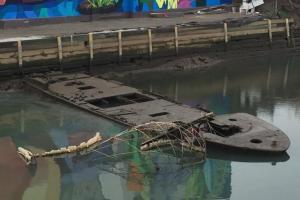
Remains of the SS Gy
The Gowanus Canal in Brooklyn is one of the most polluted waterways in the nation. When I went to work for Moore McCormack many, many years ago, their New York terminal was on 23rd Street on the Gowanus. I recall the canal as fetid and vile, a sort of milky green mass, often with a multihued sheen shimmering on the surface. Nothing significantly changed over the intervening decades. Now, however, the first stages of a clean-up have finally begun. The EPA has started dredging the stinking waterway in a $506 million federal Superfund cleanup.
The bottom of the canal is covered in a ten-foot thick toxic layer of what is described as “black mayonnaise,” a noxious mix of tar, sewage, a variety of chemicals and heavy metals mixed with rotted organic matter and anything else that has had the misfortune to sink in the canal over the past century or so.
In the dredging, a variety of artifacts have emerged from beneath the stinking sludge. The largest and most emblematic so far may be the wreck of a 63-foot long vessel with a storied history.
The boat, built by Miami Shipbuilding Corp. in 1943, served in both World War II and the Korean Wars as a “crash boat,” or more formally, an Aircraft Rescue Boat. With four engines turning out a combined 2,000 horsepower and capable of 50 knots, it was designed to rescue pilots who had crashed or been shot down.
In 1963, it was converted to a Fire Island ferry and named Point O’Woods V until it was retired in 1985.
Converted to a houseboat in 1988 and renamed the Kokkomokko, she was home to a couple on Westchester Creek in the Bronx. The houseboat sank in the winter of 2003, when a chunk of ice ripped through its hull.
The boat was patched, refloated and sold to an artists’ collective in 2005 for the $1. Renamed The Empty Vessel Project, the boat was towed to the Gowanus and opened as a public arts space. It was apparently not a notable success as the group sold the boat a year later, again for $1, to a group which used it as an LGBT party boat. The boat was officially dubbed the Green Anchor Yacht, but was more commonly referred to as the SS Gay.
The New York Post quotes artist Duke Riley, who spent time aboard it when it was the Empty Vessel Project and the SS Gay. “That boat was a pretty amazing space,” he said “Both groups sort of used it as a community space, and it was sort of like a wide-open cabin down below that was pretty spacious. It was a pretty cool moment in that time of Brooklyn — people living on the edge.”
Neither researchers nor Riley know exactly how the SS Gay ended up at the bottom of the canal. Some say it was set ablaze during a party. Riley produced an intaglio print dated July 25, 2009, and titled “The Scuttling of the S.S. Gay,” which depicts several people sinking the boat, but said the representation was fictional.
Despite the storied history in New York waterways, the boat’s historical value as a World War II relic is practically nil because of all the renovation it’s undergone.
“In its current wrecked and deteriorated state, the boat lacks integrity as an example of a World War II era ‘crash boat,’ ” researchers wrote in a report to the EPA.
“The removal of the original superstructure at the time of its conversion to a ferry and the later removal of its engines and machinery further weaken the boat’s historic integrity,” they added.
“As a result, the wreck has no archaeological value, nor is it eligible for listing in the National Register of Historic Places.”

63′ Crash boats
https://uscrashboats.org/cpage.php?pt=10
Bronx Party boat, Claire, another 63′ Crash Boat
http://shipbuildinghistory.com/smallships/armypboats.htm
Thanks Walter.
Pingback: New York History Around The Web This Week | The New York History Blog